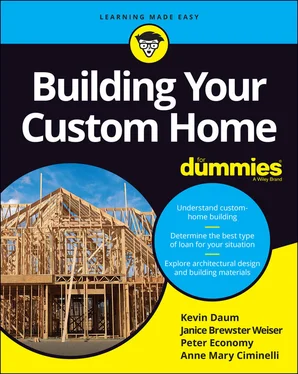What can you emotionally pay? Just because you have the money and the borrowing power doesn’t mean you really want to spend it all. Think carefully and discuss with your spouse what your limits are for making payments and how much liquidity (cash) you need in the bank to help you sleep at night when all is said and done. Make sure you take into account tax deductions and interest earned on investments when analyzing your monthly cash flow. After you’ve found your emotional limit, you can design your project to fit your comfort zone.
What’s your cushion and tolerance for risk? As we say again and again throughout this book, building a custom home is a complex process. You need to consider many variables beyond your control and then realize that the project can go over budget even if you do everything right. You can certainly get good solid estimates, but ultimately you won’t know what this home will cost until it’s finished and you total up the receipts. Make sure you’ve addressed the “what if?” issues thoroughly. Talk about how you’ll cover things financially if the market turns sour — devaluing your property — or the cost of materials rise. Decide what safety money (such as your retirement fund) you’re willing or unwilling to tap into.
 The more you talk about financial issues related to your custom-home project, the more likely you are to resolve problems before they happen. Optimism in a custom-home project can get you into trouble every time. The best approach is to examine every possible risk and make contingency plans for every potential problem.
The more you talk about financial issues related to your custom-home project, the more likely you are to resolve problems before they happen. Optimism in a custom-home project can get you into trouble every time. The best approach is to examine every possible risk and make contingency plans for every potential problem.
Them that has the gold makes the rules: If you finance, the bank will dictate process
Most people don’t have all the money for a custom home sitting in their bank accounts. Even if they did, putting it all into the project wouldn’t be a good idea, as we explain in Chapter 8. Like it or not, you’ll probably have a financial partner in this project in the form of a construction lender or bank. The good news is, construction lenders have the same objectives you do:
They want to make loans for custom-home projects. (That’s how they make money.)
They want the house to be completed on time.
They want the house to be completed on budget.
They want the house to be completed in a workmanlike manner.
Furthermore, the following tidbits can save you some arguments and frustrations when working with construction lenders:
They don’t believe a house is worth exactly what it costs.
A larger loan makes you a riskier borrower, not a better customer.
You aren’t entitled to any loan.
They aren’t required by law to loan you any money.
They dictate how the money is handled throughout the process.
Accept the fact that if you want to use a lender’s money, you have to play by their rules. Most of these rules weren’t made arbitrarily. They’re designed to protect the financial viability of the project and protect the lender in the unlikely event of a foreclosure, which is the act of taking back the home in case you default on the payments or the construction contract. The banks don’t want to foreclose on your home — they’re not in the house-selling business. Worst of all, they don’t want to foreclose on an unfinished construction project, when the property is neither an empty lot nor a finished home, but something in the dreaded middle. The guidelines and procedures are based upon statistical and anecdotal problems and failures that occurred with the lender in the past. Unfortunately, sometimes you pay for the sins of those who’ve gone before you.
 Put yourself in the lender’s shoes. If you were loaning a friend 80 percent of the money to build his home, you’d want a few protections in place and a little control over the money as well, right? If you get to know how lenders see the project, which we explain in detail in Chapters 9and 10, you can easily navigate the approval process, as well as the funding process (see Chapter 11). This approach can make for a smoother, happier custom-home project.
Put yourself in the lender’s shoes. If you were loaning a friend 80 percent of the money to build his home, you’d want a few protections in place and a little control over the money as well, right? If you get to know how lenders see the project, which we explain in detail in Chapters 9and 10, you can easily navigate the approval process, as well as the funding process (see Chapter 11). This approach can make for a smoother, happier custom-home project.
Introducing the Custom-Home Life Cycle
The first step to beginning the process is looking at all the pieces and how they go together. Your new home has a number of individual projects and transactions necessary to complete it. Your new home also needs an army of people with their expert work and services. This section breaks down in an approximate order each person required to get through the process. Then we outline each step necessary to go from land to landscaping.
It takes (more than) two to tango: A quick guide to the players
The following list is a guide to all the individual players involved in the custom-home process. You may or may not use them all; their roles can vary depending on your region and your project’s scope. The order of need may also change depending on where you start in your process.
Financial planner and/or certified public accountant (CPA): If possible, start the custom-home process by carefully assessing your finances; a financial planner or CPA can help make sure you can afford this project.
Loan officer: Your loan officer needs to be involved early and throughout the entire process. You may need to start with a refinance or credit line to get liquid (see Chapter 8). You want to finance the land (see Chapter 3) and do it consistent with the construction financing (see Chapters 9and 10). Your loan officer can help you through these steps. Lucky for you, Chapter 9also has good advice on picking the right loan officer.
Real-estate agent: You may need a real-estate agent to help you find and purchase a lot, as we discuss in Chapter 3. They also play a role when it’s time to sell your existing home.
Developer or landowner: The land you buy has to come from somewhere. If you’re buying in a subdivision from a developer, you may deal with a sales office. Or you may end up buying from a landowner who has had the property for generations.
Escrow officer or attorney: Your state determines who administers the closing of your escrow, but either way, this person makes sure the title papers and insurance are all ready for you to take ownership.
Architect and/or designer: Architects and designers design and draft plans for the house. Architects are licensed; they’ll coordinate technical specifications for the house that may be beyond the scope of a designer. The architect can also guide you through the permitting process. ( Chapter 5can help you decide if you need an architect, and Chapter 6provides the ins and outs of the permitting process.)
Log or timber frame dealer: If you’re building a kit home (see Chapter 4), you’ll work with your dealer for the design process, as well as the purchase of your materials package.
Contractor/builder: You need to decide whether you need this person or if you’ll rely on yourself to drive the construction of your new home (see the “ Being an Owner-Builder: More Power to You!” section, later in this chapter, if you may want to be your own owner-builder). We give you tools for working with your contractor in Chapter 7.
Surveyor: This person makes sure you know where your land begins and ends — a necessity for designing a house.
Soils engineer: In many states, such as California, your foundation depends upon the report issued by this person.
Well/septic engineer: If you’re building in a rural area, you need this person to design and certify your water and sewage systems.
Читать дальше

 The more you talk about financial issues related to your custom-home project, the more likely you are to resolve problems before they happen. Optimism in a custom-home project can get you into trouble every time. The best approach is to examine every possible risk and make contingency plans for every potential problem.
The more you talk about financial issues related to your custom-home project, the more likely you are to resolve problems before they happen. Optimism in a custom-home project can get you into trouble every time. The best approach is to examine every possible risk and make contingency plans for every potential problem. Put yourself in the lender’s shoes. If you were loaning a friend 80 percent of the money to build his home, you’d want a few protections in place and a little control over the money as well, right? If you get to know how lenders see the project, which we explain in detail in Chapters 9and 10, you can easily navigate the approval process, as well as the funding process (see Chapter 11). This approach can make for a smoother, happier custom-home project.
Put yourself in the lender’s shoes. If you were loaning a friend 80 percent of the money to build his home, you’d want a few protections in place and a little control over the money as well, right? If you get to know how lenders see the project, which we explain in detail in Chapters 9and 10, you can easily navigate the approval process, as well as the funding process (see Chapter 11). This approach can make for a smoother, happier custom-home project.










